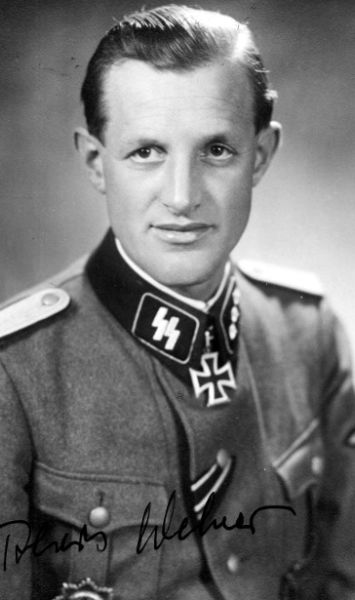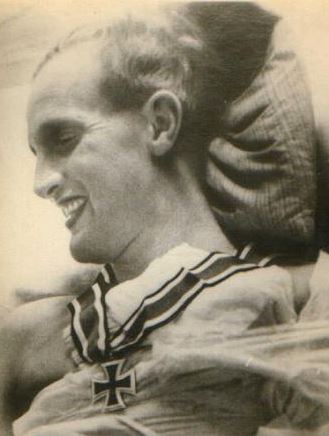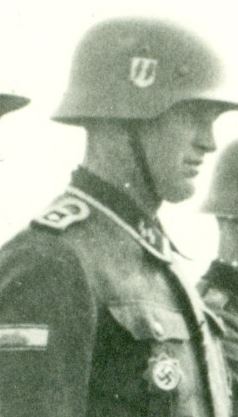Weber, Alois (Waffen SS)
- Date of birth:
- November 30th, 1915 (Blumenried/Bavaria, Germany)
- Date of death:
- January 19th, 2003 (Kempten/Bavaria, Germany)
- Service number:
- SS-Nr.: 156.963 // NSDAP-Nr.:
- Nationality:
- German
Biography
Promotions:
00.00.1940: SS-Unterscharführer
00.00.1941: SS-Oberscharführer
00.00.1943: SS-Hauptscharführer
01.07.1943: SS-Untersturmführer der Reserve
09.11.1944: SS-Obersturmführer der Reserve
Career:
00.00.1936: joined the SS-Standarte 'Deutschland', SS-VT
00.09.1939: SS-Pionier, SS-Pionier-Sturmbann, SS-Standarte 'Deutschland', SS-VT - campaign in Poland
00.05.1940: campaign in the West
00.02.1941: campaign in the Balkans
00.06.1941: campaign in Russia
00.10.1941: Rzhev
00.12.1941: Oskol, Dnjepr, Donetz
00.02.1943: SS-Oscha, Zugführer, 16. Kompanie, SS-Panzergrenadier-Regiment "Deutschland", 2. SS-Panzergrenadier-Division 'Das Reich'
00.06.1943: SS-Hascha, Zugführer, 16. (Pionier) Kompanie, SS-Panzergrenadier-Regiment "Deutschland", 2. SS-Panzergrenadier-Division "Das Reich"
00.07.1943: WIA and evacuated to a Lazarett
00.00.1945: SS-Ostuf, Chef, 2. Kompanie, SS-Pioneer-Ausbildungs- und Ersatz-Bataillon 1
Do you have more information about this person? Inform us!
- Period:
- Second World War (1939-1945)
- Rank:
- SS-Unterscharführer (Sergeant)
- Awarded on:
- June 11th, 1940
- Period:
- Second World War (1939-1945)
- Rank:
- SS-Oberscharführer (Staff Sergeant)
- Awarded on:
- July 25th, 1941
- Period:
- Second World War (1939-1945)
- Rank:
- SS-Oberscharführer (Staff Sergeant)
- Awarded on:
- July 20th, 1942
- Period:
- Second World War (1939-1945)
- Rank:
- SS-Oberscharführer (Staff Sergeant)
- Awarded on:
- August 1st, 1942
- Period:
- Second World War (1939-1945)
- Rank:
- SS-Oberscharführer (Staff Sergeant)
- Awarded on:
- March 15th, 1943
- Period:
- Second World War (1939-1945)
- Rank:
- SS-Oberscharführer (Staff Sergeant)
- Awarded on:
- April 1st, 1943
- Period:
- Second World War (1939-1945)
- Rank:
- SS-Oberscharführer (Staff Sergeant)
- Unit:
- 16. Kompanie, SS-Panzergrenadier-Regiment "Deutschland", 2. SS-Panzergrenadier-Division 'Das Reich'
- Awarded on:
- April 9th, 1943
- Period:
- Second World War (1939-1945)
- Rank:
- SS-Oberscharführer (Staff Sergeant)
- Awarded on:
- April 10th, 1943
- Period:
- Second World War (1939-1945)
- Rank:
- SS-Hauptscharführer (Sergeant Major)
- Unit:
- Zugführer, 16. (Pionier) Kompanie, SS-Panzergrenadier-Regiment “Deutschland”, 2. SS-Panzergrenadier-Division “Das Reich”, II. SS-Panzer-Korps, Heeresgruppe Süd
- Awarded on:
- July 30th, 1943
“During the attack on the 05.07.1943 the II./SS-Pz.Gren.Rgt. ‘Deutschland’ had the mission of cracking open the deeply echeloned defenses before Beresoff. After eliminating the enemy combat outposts they were to punch through the enemy’s fortified lines, capture the village itself and then seize the heavily fortified high ground northeast of Beresoff.
In order to support this attack the Bataillon was assigned a Tiger Kompanie as well as a Pionier-Zug from the 16./SS-Pz.Gren.Rgt. ‘Deutschland’. This latter unit was under the command of SS-Hauptscharführer Weber.
After the combat outposts had been eliminated the Pionier assault unit received the mission of advancing to the anti-tank ditch alongside the 6./SS-Pz.Gren.Rgt. ‘Deutschland’. After this the assault force was to eliminate the bunker positions that commanded the anti-tank ditch itself.
The friendly attacked bogged down in the enemy fire after it had reached the anti-tank ditch. The relentless and accurate artillery, mortar and sniper fire from the enemy’s deeply echeloned field fortifications and skillfully camouflaged bunkers prevented any forward advance from the anti-tank ditch by the II./SS-Pz.Gren.Rgt. ‘Deutschland’. The attached Tiger Kompanie was unable to provide support in a timely manner due to losses sustained from mines, and so any continuation of the attack only seemed to promise bloody failure.
The accurate enemy artillery fire inflicted ever higher losses in dead and wounded with each passing hour. Thus the commander of the Pionier assault unit (SS-Hauptscharführer Weber) made the bold decision to storm the commanding enemy bunker lines with his Zug despite the lack of Tiger support. By doing so he sought to bring respite to the pinned-down Kompanien of the II./SS-Pz.Gren.Rgt. ‘Deutschland’. He reconnoitred potential attack options under the heaviest of enemy fire, and eventually discovered a communications trench that was relatively well protected from hostile fire. He then assembled his Zug, pushed through the deadly blocking fire, entered into the enemy’s rear via the communications trench and fought at the head of his troops as they overran the Soviet bunker system that dominated the anti-tank ditch.
A decisive success was achieved, and yet Weber continued to storm forwards with his Pionieren in order to capitalize on their achievement. He and his men eliminated the opposing resistance in the middle of Beresoff, and then he swiftly resolved to thrust through the village and take the commanding high ground beyond it. He pursued the fleeing enemy troops, and after bitter close combat he and his squads were able to seize the bunker complex (ca. 15 large bunkers) atop of the high ground.
This bold and relentless advance into the rear of the Soviet positions broke the hitherto bitter resistance of the defenders, who were compelled to abandon the northern and southern parts of Beresoff before fleeing back across the hills towards the north in disorder. This in turn enabled the II./SS-Pz.Gren.Rgt. ‘Deutschland’ to advance beyond the anti-tank ditch, push the enemy back towards the north and reach the road that led towards Kursk.
The inspirational bravery, superior leadership and initiative of SS-Hauptscharführer Weber (his assault troop sustained only 6 casualties) enabled his Pionier assault troop to achieve a decisive feat-of-arms. This achievement constituted an invaluable element for the breakthrough of the SS-Pz.Gren.Div. ‘Das Reich’ through the 20 km deep Soviet fortification belt along both sides of Beresoff.”
Sources
- Photo 1: Willi Schumacher Collection
- Photo 2:
- Photo 3:
- - FELLGIEBEL, W.P., Elite of theThird Reich, Helion & Company Limited, Solihull, 2003.
- MOONEY, PETER, Waffen-SS Knights and their Battles, Schiffer Publishing, Ltd, 2010.
- PATZWALL, K. & SCHERZER, V., Das Deutsche Kreuz 1941-1945, Band II, Verlag Klaus D. Patzwall, Norderstedt, 2001.
- SCHNEIDER, J.W., Their Honor Was Loyalty!, Bender (R.James) Publishing, 1993.
- Die Ordensträger der Deutschen Wehrmacht (CD), VMD-Verlag GmbH, Osnabrück, 2002
- Bender R.J., Breyette T., Tank Killers, RJ Bender Publications, 2000, ISBN 0-912138-83-1
- Schneider J.W., Their Honor was Loyalty!, R. James Bender Publishing, 1977
- Microfilm Publication A3343. US National Archives













